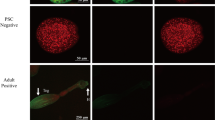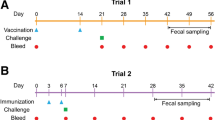Abstract
Cystic echinococcosis (CE) is a widely distributed zoonosis that is highly endemic in the Mediterranean basin. The disease represents a serious public health threat and causes economic losses. The parasite life-cycle involves dogs and ruminants as definitive and intermediate hosts; humans are accidently infected, causing serious clinical issues. Vaccination of ruminants and dog treatments represent the most efficient measures to prevent parasite transmission. The recombinant protein vaccine, EG95, has been used successfully in sheep vaccine trials against CE in several countries. In this study, we expressed the modified antigen, EG95NC-GST, in Escherichia coli for use as a vaccine against Echinococcus granulosus in ruminants. We tested three different media formulations for E. coli culture and established for each culture conditions for optimal levels of soluble EG95 expression. The results demonstrate that SOC and TB media provided high yields in cell density and EG95 protein expression. Purification of the recombinant protein with affinity chromatography (using FPLC) was also performed to increase the purity of the EG95NC−-GST antigen.







Similar content being viewed by others
Abbreviations
- CE:
-
Cystic echinococcosis
- GST:
-
Glutathione S-transferase
- IPTG:
-
Isopropyl-β-d-thiogalactoside
- LB:
-
Luria broth
- TB:
-
Terrific broth
- SOC:
-
Super broth
- FPLC:
-
Fast protein liquid chromatography
- SDS-PAGE:
-
Sodium dodecyl sulphate-polyacrylamide gel Electrophoresis
References
Moro P, Schantz PM (2009) Echinococcosis: a review. Int J Infect Dis 13(2):125–133
Schantz PM, Chai J, Craig PS, Eckert J, Jenkins DJ, Macpherson CNL, Thankur A (1995) Epidemiology and control of hydatid disease. In: Thompson RCA, Lymbery AJ (eds) Echinococcus and hydatid disease. CAB International, Wallingford
Hemphill A, Kern P (2008) Special issue: experimental studies in echinococcosis. Exp Parasitol 119:437–438
Ministry of Health Morocco, Direction de l’Epidémiologie et de la lutte Contre les maladies. Service des maladies Parasitaires, Ministry of Health Morocco, Rabat, Morocco, 2012
Ouhelli H, Kadiri A, El Hasnaoui M, Kachani M (1997) Prevalence of Echinococcus granulosus in dogs in Morocco and potential role of dogs in transmission of cystic echinococcosis. In: Anderson FL, Ouhelli H, Kachani M (eds) Compendium on cystic echinococcosis in Africa and in middle eastern countries with special reference to Morocco. Brigham Young University, Provo, 145–155
Azlaf R, Dakkak A (2006) Epidemiological study of the cystic echinococcosis in Morocco. Vet Parasitol 137:83–93
El Berbri I, Petavy AF, Umhang G, Bouslikhane M, Fassi Fihri O, Boue F, Dakkak A (2015) Epidemiological investigations on cystic Echinococcosis in North-West (Sidi Kacem province) Morocco: infection in ruminants. Adv Epidemiol 2015:104025
Lightowlers MW, Flisser A, Gauci CG, Heath DD, Jensen O, Rolfe R (2000) Vaccination against cysticercosis and hydatid disease. Parasitol Today 16:191–196
Lightowlers MW, Lawrence SB, Gauci CG, Young J, Ralston MJ, Maas D, Heath DD (1996) Vaccination against hydatidosis using a defined recombinant antigen. Parasite Immunol 18:457–462
Manderson D, Dempster R, Chisti Y (2006) A recombinant vaccine against hydatidosis: production of the antigen in Escherichia coli. J Ind Microbiol Biotechnol 33:173–182
Lightowlers MW, Jensen O, Fernandez E, Iriarte JA, Woollard DJ, Gauci CG, Jenkins DJ, Heath DD (1999) Vaccination trials in Australia and Argentina confirm the effectiveness of the EG95 hydatid vaccine in sheep. Int J Parasitol 29:531–534
Heath DD, Jensen O, Lightowlers MW (2003) Progress in control of hydatidosis using vaccination—a review of formulation and delivery of the vaccine and recommendations for practical use in control programmes. Acta Trop 85:133–143
Gauci CG, Jenkins D, Lightowlers MW (2011) Strategies for optimal expression of vaccine antigens from taeniid cestode parasites in Escherichia coli. Mol Biotechnol 48:277–289
Laemmli UK (1970) Cleavage of structural proteins during the assembly of the head of bacteriophage T4. Nature 227:680–685
Bradford MM (1976) A rapid and sensitive method for the quantitation of microgram quantities of protein utilizing the principle of protein-dye binding. Anal Biochem 72:248–254
Billman-Jacobe H, Hodgson ALM, Lightowlers M, Wood PR, Radford AJ (1994) Expression of ovine gamma interferon in Escherichia coli and Corynebacterium glutamicum. Appl Environ Microbiol 60:1641–1645
Broedel SE Jr, Papciak SM, Jones WR (2001) The selection of optimum media formulations for improved expression of recombinant proteins in E. coli, vol 2. Athena Environmental Sciences, Inc., Baltimore
Zanette D, Dundon W, Soffientini A, Sottani C, Marinelli F, Akeson A, Sarubbi E (1998) Human IL-1 receptor antagonist from Escherichia coli: large-scale microbial growth and protein purification. J Biotechnol 64:187–196
Lim H-K, Jung K-H, Park D-H, Chung S-I (2000) Production characteristics of interferon-a using an l-arabinose promoter system in a high-cell-density culture. Appl Microbiol Biotechnol 53:201–208
Korz DJ, Rinas U, Hellmuth K, Sanders EA, Deckwer W-D (1995) Simple fed-batch technique for high cell density cultivation of Escherichia coli. J Biotechnol 39:59–65
Funding
This work was funded by MCI animal health company.
Author information
Authors and Affiliations
Contributions
MH, KT and ML initiated the study, participated in experimental design. MJ conducted the experiment. All authors participated in data analysis; interpretation of the results, MJ, MH wrote the paper and ML review it. All authors read and approved the final manuscript.
Corresponding author
Ethics declarations
Conflict of interest
The authors declare that they have no competing interests.
Ethical Approval
No human or animal subjects were used in this study. Declarations of ethical treatment of human subjects or animals, or consent of human subjects are therefore not applicable.
Rights and permissions
About this article
Cite this article
Jazouli, M., Lightowlers, M., Gauci, C.G. et al. Vaccination Against Hydatidosis: Molecular Cloning and Optimal Expression of the EG95NC− Recombinant Antigen in Escherichia coli . Protein J 36, 472–477 (2017). https://doi.org/10.1007/s10930-017-9742-x
Published:
Issue Date:
DOI: https://doi.org/10.1007/s10930-017-9742-x




